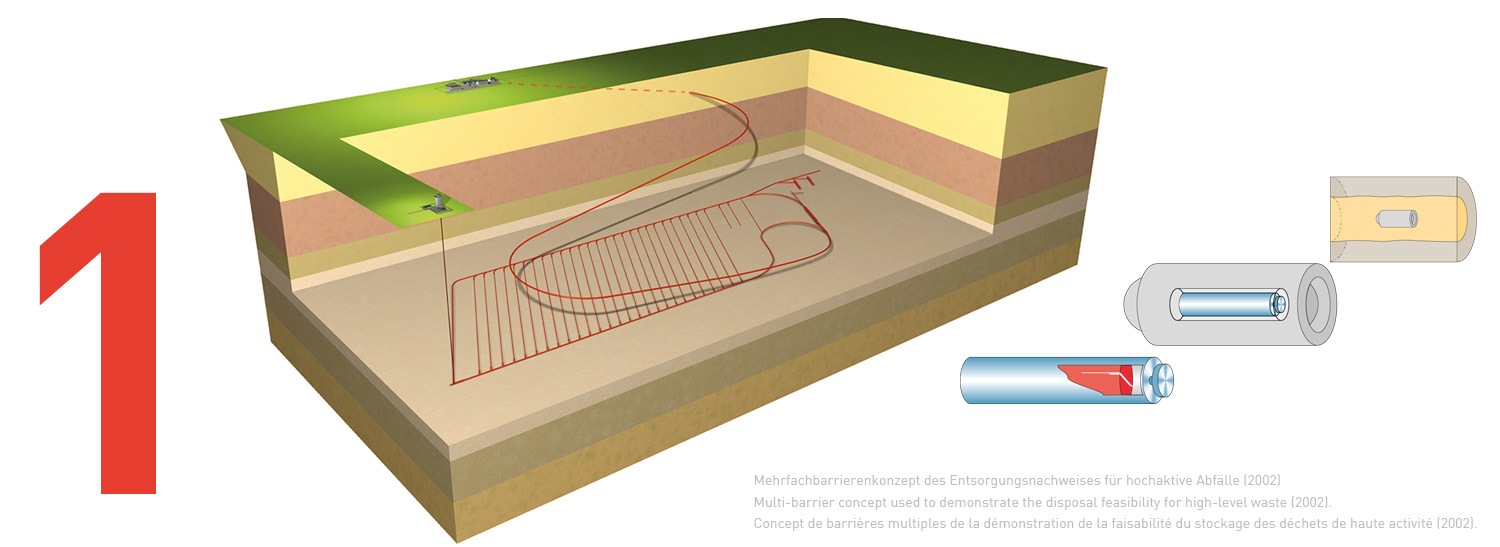Switzerland has been using nuclear energy to generate electricity for over 50 years. Consequently, it has been producing radioactive waste during this period. Article 51 of the Swiss Nuclear Energy Ordinance (KEV) defines three waste categories: high-level waste (HLW), alpha-toxic waste (ATW) and low- and intermediate-level waste (L/ILW).
- HLW consists of spent fuel assemblies from nuclear power plants (NPPs) and vitrified waste from the reprocessing of spent fuel assemblies.
- ATW partially originates from reprocessing, but also from applications in medicine, industry and research (MIR).
- L/ILW mostly results from the operation and dismantling of nuclear facilities, although only a small proportion of the operational waste and dismantling materials is radioactive.
Radioactive waste from the nuclear power plants is currently stored in on-site storage facilities and in the centralised Zwilag interim storage facility located in Würenlingen. The federal government stores MIR waste in the Swiss Federal Interim Storage Facility at the neighbouring site of the Paul Scherrer Institute (PSI).
In Switzerland, the disposal of all radioactive waste in a deep geological repository is stipulated in the Nuclear Energy Act (KEG). By disposing of the waste deep below ground, it is possible to avoid potential social and technological consequences of civilisation at the earth’s surface. This is a prerequisite for ensuring the necessary safety over long periods of time.
The time period for assessment which, in the case of HLW, is one million years, is derived from the decrease with time of the radiological hazard potential. The complete containment of radionuclides over this long time period is not possible, but also not necessary. With the concurrent decrease of the hazard potential over time, the very slow release of radionuclides is not critical to the safety of the repository.
COMPLIANCE WITH THE PROTECTION OBJECTIVE
To demonstrate post-closure safety, plausible evidence must be provided that the protection of humans and the environment can be ensured (Art. 13, KEG). This protection objective is specified more precisely using protection criteria contained in a pdf guideline(590 KB) of the Swiss Federal Nuclear Safety Inspectorate (ENSI), e.g. by defining a maximum permissible individual dose. Overall, at no point in the evolution of a deep geological repository may the release of radionuclides exceed an individual dose of 0.1 millisieverts (mSv) per year.
Compared with the radiation exposure received by the population of Switzerland each year, 0.1 millisieverts is a small value: two transatlantic flights would already result in a similar radiation exposure. The current average radiation dose to the Swiss population is around 6 millisieverts per year. The safety analyses for nuclear facilities must take into account irreducible uncertainties by means of conservative assumptions. This means that the radiological impacts on humans and the environment tend to be overestimated.
FEASIBILITY DEMONSTRATION
The feasibility of long-term safe deep geological disposal in Switzerland has been demonstrated for both L/ILW and HLW. These so-called “Entsorgungsnachweise” include a siting demonstration, a feasibility demonstration and a post-closure safety case. The demonstration of pdf disposal feasibility for L/ILW(199 KB) in a marl formation at the “Oberbauenstock” site was confirmed by the Federal Council in 1988.
The corresponding pdf demonstration for HLW(150 KB) submitted in 2002 was based on the example of a repository in the Opalinus Clay in the Zürcher Weinland region and was recognised by the Federal Council following a review by the responsible authorities and numerous national and international experts.
The demonstration of disposal feasibility for HLW is based on a system of geological and engineered safety barriers (multi-barrier concept). The disposal canisters ensure the safe confinement of the radioactive waste for a long time period, during which most of the radionuclides will decay in the canisters (around 90% over a time period of 1,000 years). After this, the remaining radionuclides will be retained by the backfill material (bentonite) emplaced between the canisters and the surrounding host rock (Opalinus Clay).
The siting region ensures that, even under conservative assumptions, the conditions favourable for the retention of the radionuclides can be preserved during the time period for assessment. Besides the already established treatment and packaging of radioactive waste for interim storage, its characterisation and inventorying as well as interim storage and the associated transports, the demonstrations of disposal feasibility represent important steps in the management of Switzerland’s radioactive waste.
The site of the deep geological repository has not yet been legally approved. In accordance with Article 5 of the KEV, it is to be determined within the framework of the site selection process.

